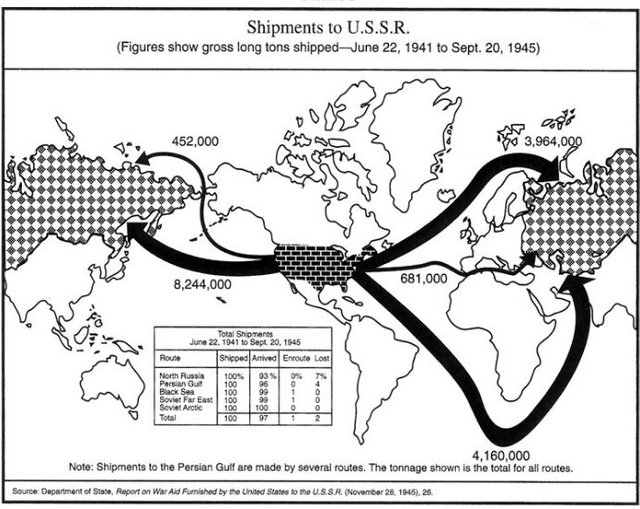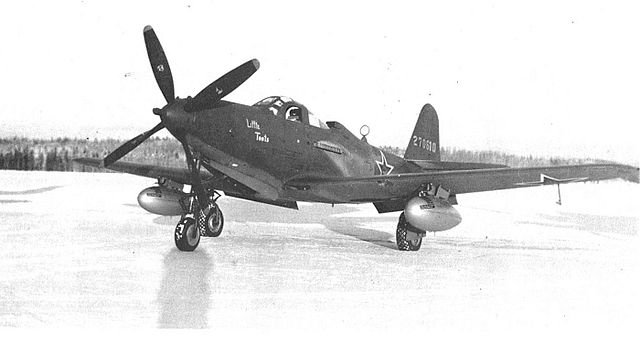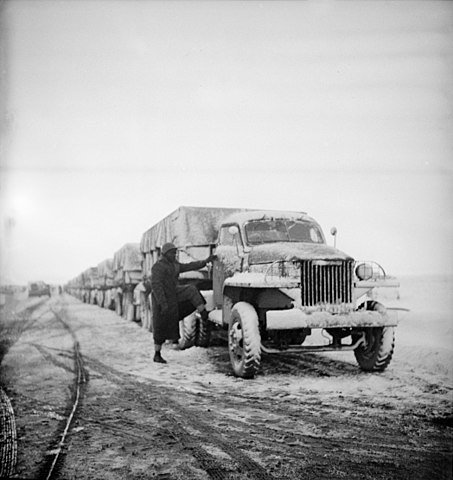How Allied aid kept the Soviets fighting WWII
When the Germans attacked the USSR, the extension of the Lend-Lease to Russia seemed inevitable. That's why the first retreats of the Red Army were so disturbing in the United States. The Americans seriously doubted the ability of the USSR to change the situation during the winter of 1941 - 1942.
Hopkins, a friend and advisor of Roosevelt, travelled to Moscow and met Stalin, where he had a meeting with the Georgian (June 30th) in which he told the American about the military situation in all its crudeness (which he rarely did). Asserting with certainty that the USSR could resist, and that after the winter it would propose a strategic change in the war situation.
Appealing for the welfare of the British and Americans who, according to him, now depended on the resistance capacity of the USSR. Stalin convinced Hopkins that the USSR would not be defeated.
On October 1st, the US and the USSR signed an agreement for $1 billion in supplies, to be distributed over nine months under a regulatory framework. But on October 30th, Roosevelt extended the lend-lease to the USSR. Despite the terrible military situation on the German-Soviet front (the invasion of Ukraine in September forced the Red Army into a hasty retreat), aid remained. At first it was very modest, at the end of November 1941 it was 79 light tanks, 59 fighters and 1,000 trucks.
The Americans' modest deliveries made the British think about sending the Russians some of their material. There were three routes for this operation: Vladivostok, Murmansk and Persia. In the end, the first two were discarded due to the risk of U-Boat attacks and the Trans-Siberian route was chosen.

Image wikipedia
Despite the losses, the Arctic route allowed the movement of 22,000 vehicles, 2,795 tanks, 1960 planes, 527,000 tons of ammunition, 44,500 tons of fuel, a quarter of everything delivered to the Soviets during the war. But from 1943 onwards, the Soviets minimised Allied aid and wanted to prevent their people from learning about this at all costs.
Stalin wanted his people to think USSR was fighting alone and without foreign support. This lie was contemporary with an increase in Soviet production.
The Soviets concentrated their efforts on the relocation and start-up of their industries, far from German range, allowed, since 1943, the production of the essential in Soviet territory. Since the end of that year, Soviet production has far exceeded German production.
U.S. aid was heavily criticized. The USSR always played it down. Something to mention, even though the quality of the supplies was often flawed.
One could object to the large number of cases in which US assembly lines were able to compensate for any failures. And we must not forget that among the military equipment were Hudson bombers, the Airacobra or Kittyhawk fighter-bombers, praised by the High Command of the Red Army. And the Shermans who had nothing to envy from most of the tanks. U.S. aid to the volume of Soviet military production gave rise to some clever calculations to diminish its importance. But it is estimated that it was between 10 and 15%. But this is only until 1944.
From 1945 onwards, deliveries multiplied and the most important ones took place. The red army gained movement capacity. They also filled a gap in tactical bombers and transmissions.
And what about fuel?
As soon as the German offensive on the Caucasus began in the spring of 1942, 2,600,000 tons of oil were supplied by the United States, including 426,000 tons of high-octane gasoline, allowing the Soviet air force to maintain the pace of its exits to face the Luftwaffe.

P-63A-10-BE Kingcobra, in Red Air Force markings (Wikipedia)
Moreover, the astonishing range of products that arrived in the USSR is sufficient to indicate the extent to which it was able to cover the shortcomings of the Soviets and the socialist economy.
The figures speak for themselves. In terms of rolling stock alone, some 700,000 trucks, 5,000 jeeps, 35,000 motorcycles and 8,000 artillery tractors, to which 3,800,000 tyres were added.

Somewhere in the Persian corridor. A United States Army truck convoy carrying supplies for Russia. Snow covered trucks start pushing through the mountain passes of Iran. 1943. (Wikipedia)
The same was true for railway equipment: 2,000 locomotives and some 11,000 wagons adapted to the full width of the Soviet tracks. In terms of transmissions, 300,000 campaign telephones and 5,000 radar and radio communication stations.
On the economic front, all economists insist that the shipment of raw materials was essential to the Russian war effort: 1,200,000 tons of steel, 1,700,000 tons of aluminum, 103,000 tons of rubber, 50,000 tons of leather and significant quantities of non-ferrous materials (tin, nickel, lead, zinc), without which it was not possible to maintain a war economy.
The successes of the Wehrmacht in the summer of 1941 deprived the Soviets of their main food pantry. In this case too, the Allied aid was essential to ensure the supply of the population and the army with 4,500,000 tons of various food products (flour, meat and sugar).
Even though the $10 billion of Allied aid represented only a relatively weak share of Soviet arms production (about 20% of the total), it is impossible to deny the impact it had on the Eastern front.
Many people today forget that the nation that benefited most from the Lend-Lease program was not the USSR, it was the UK. The contributions to the UK were 3 times larger than those received by Russia. With one difference...the USSR has not paid a cent of the "loan" received to date.
Conclusions
- U.S. aid was very little in the first year of the German invasion of Russia. The failure of Barbarossa or the battle for Moscow was not influenced by foreign aid.
- The Russian offensives of 1942-43, Bagration (44) or later, could not have been carried out as we know them, without the help of the Allies.
- The arms supplied represented only 10-15% of Russian production during the entire war, but the raw materials, fuel, food or technology provided were fundamental to the Soviet war effort from 1942 onwards.
Sources
- Weeks, A. L. (2004). Russia's Life-saver: Lend-lease Aid to the USSR in World War II. Lexington Books.